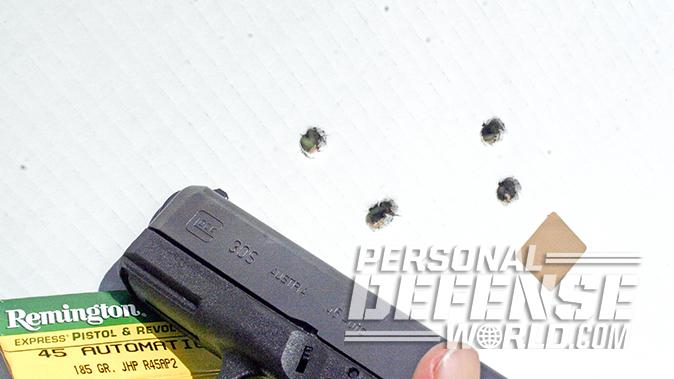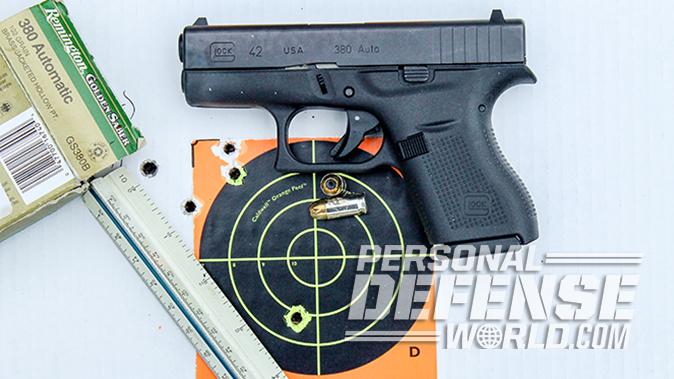I must have missed the treaty the bad guys signed that promised they’d allow the good guys to get closer to shoot them more effectively if they were armed with only short-barreled guns. In a time when mass murderers open fire in spacious shopping malls, when more criminals than ever seem to know how to use cover effectively, it’s more important than ever for armed citizens to be able to deliver a truly precise shot, sometimes at significant distances.
In recent years, a San Antonio cop killed a gunman at over a 100 yards. Elsewhere in Texas, an armed citizen in his 60s opened fire from some 65 yards away and dropped a multiple murderer who was firing a rifle at a police officer. Those good guys were armed, respectively, with a full-sized SAPD-issued Smith & Wesson M&P40 and a 6-inch-barreled Colt Python revolver in .357 Magnum. What if you or I were in the same situation and had to make that kind of a shot with smaller short-barreled guns?
Accurate Snubbies
One of my friends and early graduates is a cop in Georgia named Bobby Tribble. One day he was off-duty in a mall when a heavy-duty armed robbery went down. He wound up shooting it out with a thug who was armed with a Ruger P90 in .45 ACP, a very accurate pistol. Bobby only had his little S&W Model 642, a five-shot .38 Special J-Frame with a barrel only 1.9 inches in length. Bobby won the gunfight, scoring multiple man-stopping hits with that little snub-nose .38. The distance? A measured 23 yards.
Advertisement — Continue Reading Below
In 1972, Nolan Santy, Richard Brown and I formed a pistol team at the small police department in southern New Hampshire where we all worked as part-time cops. PPC was the only game in town then, and a year or so later we sponsored the first NRA-sanctioned New Hampshire State PPC Championship. For the obligatory side match for off-duty guns (only snub-nose .38/.357 revolvers at the time) we did something extraordinary and included a 50-yard component. The other snubbie matches we shot in the Northeast were limited to 25 and even 15 yards, with the sponsors explaining that 2-inch-barreled guns were so hard to shoot they thought cops would hit each other’s targets that far away. Maybe New Hampshire cops just shoot really well.
The simple fact is that a shorter sight radius opens the door to more human error. A grip designed to be very small for maximum concealment is not conducive to the strongest hold. The inherent accuracy is there, however—the shooter just has to work harder to bring it out.
Advertisement — Continue Reading Below
Over the years, I’ve made it a habit to test even small pocket guns at the regulation “gun magazine distance” of 25 yards that is standard for full-sized service handguns. Some of those little shorties have delivered pleasant surprises.
When I tested the odd little 2-inch-barreled Chiappa Rhino from a benchrest at 25 yards, the first shot hit dead-center on the tiny target paster I was using for an aiming point. My best five-shot group of that day measured 1.3 inches. Both that first center shot and the five-shot group were produced with Magtech 125-grain Guardian Gold .357 Magnum JHPs.
Accurate Semis
I’ve accumulated a lot of Glock pistols over the years and carry them often. My single favorite is the subcompact G30, which holds 10+1 rounds of .45 ACP. My first G30 impressed me so much when I tested it right after its introduction in 1998 that I bought it. I still have it along with a G30S and G30 SF in stock configuration. I’ve won matches shooting them against full-sized .45s, and a few times have won Major Sub events at Glock Sport Shooting Foundation (GSSF) matches with them.
Advertisement — Continue Reading Below
My very first one has twice given me five-shot groups that measured less than 0.9 inches at 25 yards, once with Federal Hydra-Shok 230-grain JHPs from a benchrest and once with Remington 185-grain Match rounds while standing on the right side of a barricade at a range in Washington state. All of the G30 pistols have 3.8-inch barrels, and did I mention that Glock lists them as “subcompacts”?
Glocks smaller than the .45 still deliver accuracy and “shootability.” A few years ago, Danny Ryan, the moderator of the GSSF section at glocktalk.com, noted that several times the overall winner or “Glockmeister” beat all the scores with the service-sized Glock 17s and such, including their own, with their “baby Glock” Glock 26 subcompacts at GSSF matches. I tried it for the hell of it, and I’ll be damned if the little gun’s scores didn’t equal what I shot with the larger Glocks. For the last several years, I’ve shot in Competition (to warm up), Master Stock,and Subcompact GSSF events with the same Glock 26. I tend to be better warmed up for the Subcompact category, which I shoot last, and the strategy worked for me at my last such event where I earned a new pistol in the Subcompact division.
It is theorized that the smaller Glocks shoot tighter than the bigger ones because their barrel/slide assemblies are proportionally more rigid. All I can say is that my first Glock 26 from 1996 with its 3.6-inch barrel shoots tighter (about 2.5-inch groups from a bench at 25 yards) than most of my full-sized Glock 17s. My subcompact Glock 27 in .40 S&W, which once put five 155-grain Winchester Silvertip rounds into 1.5 inches from an impromptu benchrest at the Sand Burr Gun Ranch in Indiana, always outshot my full-sized Glock 22 in the same caliber. The accuracy factor holds true all the way down to the .380 ACP Glock 42, with which many master-class shooters have used to shoot perfect targets out to 28 yards from standing positions in GSSF’s Pocket Glock event.
Advertisement — Continue Reading Below
Glock is not the only company that manufactures small polymer-framed pistols that area also very precise. Smith & Wesson’s M&P Shield subcompacts have ergonomics that make them eminently “shootable” and accurate right out of the box. S&W’s .45 ACP version is particularly accurate; the one I tested delivered a 1.85-inch five-shot group from a 25-yard benchrest with Remington 185-grain JHPs. The Shields are subcompacts with single-stack magazines; S&W’s M&P Compacts with double-stack magazines also deliver the goods. The M&P Compact 9mms I’ve shot invariably outperformed the full-sized M&P service pistols in the same caliber.
When chambered for .357 SIG, which Smith & Wesson now unfortunately produces only on special order from police departments, the M&P Compact delivers extraordinary accuracy. My friend Steve Denney, a retired police supervisor and current trainer, has a .357 SIG M&P Compact that I’ve seen deliver 25-yard groups from a benchrest that measured barely over an inch for five shots.
The .357 SIG is an inherently accurate cartridge it seems in all size guns for which it is chambered. When George Harris was the lead instructor at the Sig Sauer Academy, he took his annual deer with a subcompact Sig P239 in .357 SIG. I don’t recall him ever needing more than one perfectly placed shot regardless of the distance involved.
Advertisement — Continue Reading Below
Short-Barreled Guns Out To 100
Why stop at 25 yards? On the police competition NRA B-27 silhouette target, there is a tiny replica of the silhouette in the upper left corner that serves as a scoring guide. One thing we learned when practicing for those snubbie matches some four and a half decades ago was that if the shooter could keep all of his or her shots on “the little guy in the corner” at 7 yards, he or she could keep them all on the man-sized silhouette at a 100 paces.
In 38 years as an expert witness for the courts in weapons-related cases, a couple of times I’ve had occasion to demonstrate this. About 30 years ago, famed Miami attorney Jeff Weiner was defending a man who had grabbed a shotgun and chased a suspect who terrorized and robbed him and his secretary. Hoping to make a citizen’s arrest, he caught up with the gunman and, from some 50 feet away, ordered him to halt. The attacker spun on him with a stolen Charter Arms Undercover snub-nose .38, and the client killed him with a single blast of magnum 12-gauge #1 buckshot. Janet Reno, known for her anti-gun policies, was the state’s attorney for the region at the time, and she charged the armed citizen with manslaughter.
Advertisement — Continue Reading Below
In my deposition, the assistant state’s attorney prosecuting the case scoffed at my statement that the defendant was in deadly danger from a man with a short-barreled revolver 50 feet away. He sarcastically asked how far away I would need to be to feel safe from a man with such a gun. I almost answered “Oh, maybe Kenosha,” but caught myself, and instead replied for the record that at 100 yards I would still consider a man so armed capable of killing me. He started writing furiously on his legal pad, and I knew it was going to come up when he cross-examined me at trial.
So, as soon as possible, I went to the range with a notary public to memorialize the test and set up a silhouette at 100 yards. With a Charter Arms Undercover, I registered two hits out of five shots at that distance, and got the same with a S&W Model 36 Chief’s Special. A S&W Model 12 Airweight gave me three hits for six shots, and my wife’s Colt Detective Special gave me six for six. All had 2-inch barrels. The prosecutor decided not to go to trial after all.
Years later, ace pro-gun lawyer Penny Dean had a case in which the lethality of a subcompact Glock 27 in .40 S&W at long range became an issue. We went to the 100-yard line again with my own Glock 27 and a nine-round magazine of Federal Hydra-Shok ammunition. The gun gave me eight hits for nine shots on the silhouette, and I suspect I jerked the trigger for the flyer. She won her client an acquittal.
Advertisement — Continue Reading Below
At the Sand Burr Gun Ranch in Rochester, Indiana, champion shooter and master S&W revolversmith Denny Reichard teaches classes along with his daughter and son-in-law, Ashley and Austin Gibbons, on mastering small snub-nose revolvers. The course encompasses hitting steel LaRue Tactical knock-down targets from 100 yards with these little “belly guns.” And their students don’t just shoot at the steel—they hit it from that distance.
Bottom line: Don’t sell smaller handguns short for long-distance accuracy. Take a hard hold. Smoothly roll the trigger straight back. Get a perfect sight picture and know your trajectory, and no murderous gunman 100 yards away will be safe from the rescuing gunfire you can deliver with your small concealed-carry handgun.
Advertisement — Continue Reading Below
































